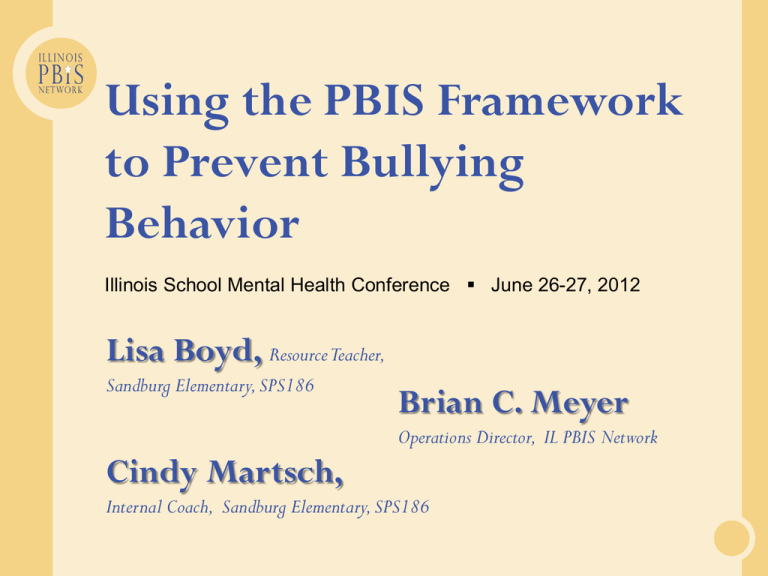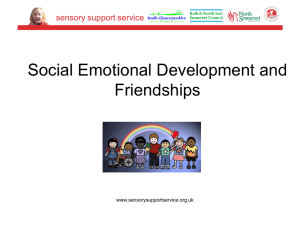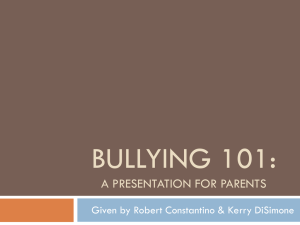
Using the PBIS Framework
to Prevent Bullying
Behavior
Illinois School Mental Health Conference June 26-27, 2012
Lisa Boyd, Resource Teacher,
Sandburg Elementary, SPS186
Brian C. Meyer
Operations Director, IL PBIS Network
Cindy Martsch,
Internal Coach, Sandburg Elementary, SPS186
Is there a need for bully prevention
in your school or district?
How do we build the necessary
systems to support bully prevention
efforts?
Outcomes
Session Description:
This session will provide research, systems, and examples of
implementing effective and sustaining bullying prevention
within a school-wide system of multi-tiered supports. A
systems framework, explicit social skills instruction, and
redefinition of the bullying construct will be emphasized to
focus the social attention among students on building an
appropriate and positive school climate.
By the end of the overview, you will be able to:
•
•
•
•
•
•
Define bullying behaviors
Identify ineffective practices with current bullying prevention programs
Understand how bullying prevention fits into the PBIS framework
Identify core features of effective bullying prevention
Know the student routines needed for effective bullying prevention.
Know the staff supports and routines needed for effective bullying prevention
Three Words…
Introduce yourself to your shoulder partner (name,
organization, position). Name three words that you
associate with bullying behaviors.
What is Bullying?
“Bullying” is repeated aggression, harassment, threats or
intimidation when one person has greater status or power
than the another.
“Not stopping a repeated pattern of
behavior that has been addressed”
- Grant Middle School, Grant SD110
What Does it Look Like?
•
•
•
•
•
•
•
Physical aggression
Repeated acts of isolation
Name calling
Cyber bullying
Rumors
Threats
Comments about race, gender, socio-economic status, disability, sexual
orientation
What are Characteristics of Bullying?
• Bullying is behavior, not a trait or
diagnosis
• Bullying behavior occurs in many forms,
and locations, but typically involves
student-student interactions.
Bullying is seldom maintained by feedback
from adults
• What rewards Bullying Behavior?
Likely many different rewards are effective
Most common are:
–
–
–
–
Attention from bystanders
Attention and reaction of “victim”
Self-delivered praise
Obtaining objects (food, clothing)
Scott Ross, University of Oregon
The Logic:
Why invest in Bullying Prevention?
•
The National School Safety Center (NSSC)
called bullying the most enduring and
underrated problem in U.S. schools.
•
(Beale, 2001)
•
Nearly 30 percent of students have reported
being involved in bullying as either a
perpetrator or a victim
GLSEN, 2009)
(
•
(Cook, Williams, Guerra, & Kim, 2010; Nansel, et al., 2001;
Swearer & Espelage, 2004)
•
Victims and perpetrators of bullying are
more likely to skip and/or drop out of school.
(Berthold & Hoover, 2000; Neary & Joseph, 1994)
•
Victims and perpetrators of bullying are
more likely to suffer from underachievement
and sub-potential performance in
employment settings.
(Carney & Merrell, 2001; NSSC, 1995)
84.6% of LGBT students reported being verbally
harassed, 40.1% reported being physically
harassed and 18.8% reported being physically
assaulted at school in the past year because of
their sexual orientation
Students on the autism spectrum are more likely
to be victimized than their non-disabled peers
•
(Little, 2002)
40-60% of students with intellectual disabilities
report being bullied. But not at a level of
intensity or chronicity that differs from typically
developing adolescent
( Christensen, Fraynt, Neece & Baker, 2012)
The Logic: Additional Research
Espelage, D. L., & Swearer, S. (2003). Research on school bullying and
victimization: What have we learned and where do we go from here? School
Psychology Review. 23(3). 365-383.
Good, C. McIntosh, K., & Gietz, C. (2011). Integrating bullying prevention into
school-wide positive behavior support. Teaching Exceptional Children. 44 (1).
48-56.
Illinois PBIS Network (2010). Technical assistance brief: effective bulling
prevention (BP) within a school-wide system of positive behavior interventions
& supports. Retrieved from www.pbisillinois.org/curriculum/bullying
Mayer, M.J. (2008). Fact Sheet #1: Overview of school violence prevention.
Retrieved from Consortium to Prevent School Violence website
Ross, S., Horner, R., & Stiller, B. (2008). Bully prevention in positive behavior
support in Elementary Schools/Middle Schools. OSEP Center on Positive
Behavioral Interventions and Supports. Eugene, OR.
Sugai, G., & Horner, R. (2011). Reducing the effectiveness of bullying behavior in
schools. OSEP Center on Positive Behavioral Interventions and Supports
website. Eugene, OR.
Common Elements of an Ineffective
Bullying Prevention Effort:
• Problem #1: Many bullying prevention programs focus on only the bully and the victim
– Ignores the role of the bystander
– not enough attention on ALL kids
• Problem #2: Inadvertent “teaching of bullying” with possible contraindicated practices
– Labeling behavior as bullying rather than being disrespectful; peer mediation; certain
“counseling” groups; anti-bullying posters or pledges, etc.
• Problem #3: Blame the bully
– Labeling kids
– Over-emphasis on student ‘responsibility’ for change
• Problem #4: Ignore role of “bystanders”
– Fails to address the social attention given by bystanders that reinforces the bullying
behavior (cheering, gathering, watching)
• Problem #5: Initial effects gained without sustained impact
– Non-data based decisions & interventions, generic intervention responses,
– Do not scale, sustain, and/or generalize – most gone 2 years after implementation
• Problem #6: Expensive effort
RESEARCH SUMMARY
What DOES NOT Work Well:
• Profiling approaches to identify
potentially dangerous students
don’t work and hurt innocent
students
• Zero tolerance policies do very
little to prevent or reduce school
violence
• Repeated suspensions of
students with behavior problems
does little to change anti-social
behaviors and often accelerates a
negative cycle of school failure
and delinquency
• Primarily punitive disciplinary
approaches that neither teach
nor reinforce appropriate
behavior are not very effective at
changing student behavior
• Stand alone curriculum does not
sustain, and difficult to
implement
• Bullying groups/ Group
counseling
• Motivational Speakers,
regardless of how funny we are,
or the emotions we envoke
• Bully posters/ Campaigns
reinforce the anti-social behavior
• Labeling students and attempting
to punish can increase bullying
• Peer mediation
Core Elements of an Effective
Bullying Prevention Effort:
• What do we need?
Bullying prevention that is efficient and “fits”
WITHIN existing behavior support efforts
Bullying PREVENTION; not just remediation
Early intervention. Teach pro-social school-wide
expectations. Address multiple levels of the student’s
ecology (school, peer, family)
Bullying prevention within a SYSTEMS APPROACH
that help to make the program sustainable.
Tiered Supports. Consistent reinforcement. Data-based
decision making.
School-Wide Systems for Student Success:
A Response to Intervention (RtI) Model
Academic Systems
Behavioral Systems
Tier 3/Tertiary Interventions
1-5%
1-5%
Tier 3/Tertiary Interventions
•Individual students
•Assessment-based
•High intensity
Tier 2/Secondary Interventions
•Individual students
•Assessment-based
•Intense, durable procedures
5-15%
5-15%
Tier 2/Secondary Interventions
•Some students (at-risk)
•High efficiency
•Rapid response
•Small group interventions
•Some individualizing
•Some students (at-risk)
•High efficiency
•Rapid response
•Small group interventions
• Some individualizing
Tier 1/Universal Interventions 80-90%
•All students
•Preventive, proactive
Bullying
Prevention
starts here
80-90% Tier 1/Universal Interventions
•All settings, all students-SYSTEMIC
•Preventive, proactive
•Data, Systems, Practices
•Faculty implementation
•Student use of BP
•Decision rules for Tier 2/3 supports
Illinois PBIS Network, Revised May 15, 2008. Adapted from “What is school-wide PBS?” OSEP Technical Assistance
Center on Positive Behavioral Interventions and Supports. Accessed at http://pbis.org/schoolwide.htm
Six Features of Universal PBIS that Contribute
to Effective Application of Bullying Prevention:
1.
The use of evidence based instructional principles to teach expected
behaviors to all students. (Behavioral lesson plans from Matrix)
2.
The monitoring and acknowledgement of students for engaging in
appropriate behavior. (Three tiers of acknowledgements: highfrequency, intermittent, long term)
3.
Specific instruction and pre-correction to prevent bullying behavior
from being rewarded by victims or bystanders. (Direct instruction of
school-wide expectations)
4.
The correction of problem behaviors using a consistently
administered continuum of consequences. (T-Chart)
5.
The collection and use of information about student behavior to
evaluate and guide decision making. (Data)
6.
The establishment of a team that develops, implements, and
manages. (Universal Team)
Fully Implementing IL PBIS Schools
Have Fewer ODRs related to Bullying
Behavior
•
•
•
•
Disrespect
Harassment
Fighting
Aggression
A strong foundation for installing
Bulling Prevention
Average ODRs for ‘Bullying’ Behaviors
Comparison of Fully & Partially Implementing
IL PBIS Schools
43%
Difference
2009-10
A three part approach
to school-wide Bully Prevention
• Establish a whole-school social culture where
positive behavior is “expected” and rewards for
bullying are NOT provided.
• Provide training and support for adults to (a) train,
(b) precorrect, and (c) provide consequences for
bullying
• Provide direct, individualized support for students
who engage in “bullying” or “victim” behaviors.
Implementing Bullying Prevention:
3 Phases for Students
• Step 1: Teach Respect
School-wide
Exploration
• Step 2: Build consensus
for preventing bullying
• Step 3: Select a stop
Installation
signal
• Step 4: Orient then Train
all students in four
Implementation
skills/routines (Stop,
Bystander Stop, Stopping,
Recruiting Help)
Students: Step 1
Teach Respect to All Students
• Should be initially taught as part of beginning of the
year kick-off.
• Students should be able to identify between
respectful and disrespectful behavior student to
student, student to adult, and adult to student
• Tier 1 team monitors school-wide data monthly,
acknowledges strengths, and coordinates reteaching of school-wide expectations as necessary
Scott Ross, University of Oregon
Students: Step 2
Building Consensus
• Collect student climate survey data
Is relational aggression perceived as a problem?
• Hold student Forums for MS/HS
Different formats possible
• Share results with whole student-body
Scott Ross, University of Oregon
Students: Step 2
Building Consensus
Student Climate Survey
In your school:
1. You feel safe.
2. Other students treat you respectfully?
3. You treat other students respectfully?
4. Adults treat you respectfully?
5. You treat adults in your school respectfully.
In the past week:
6. Has anyone treated you disrespectfully?
7. Have you asked someone to “stop?”
8. Has anyone asked you to “stop?”
9. Have you seen someone else treated disrespectfully?
DISAGREE…………AGREE
1 2 3 4 5
1 2 3 4 5
1 2 3 4 5
1 2 3 4 5
1 2 3 4 5
1
1
1
1
2
2
2
2
3
3
3
3
4
4
4
4
5
5
5
5
Students: Step 2
Building Consensus
Student Forum (MS/HS)
• Design:
•
•
8-10 students selected for leadership/contribution
60-90 min
• Introduction and Logic:
•
•
School should be a safe and welcoming place.
Disrespectful behavior is maintained if (a) it results in attention from students, and (b) is
not addressed by adults.
• Content of discussion:
•
•
•
1. Is disrespectful behavior a problem? What is the impact of disrespectful behavior on
ability of others to succeed in school.
2. Disrespectful behavior typically keeps happening because it results in attention from
peers.
3. We need common (school-wide) routines for:
– A) Stop Routine (What would be an acceptable word/gesture to indicate “stop?”)
• If someone is disrespectful toward you
• If you encounter someone being disrespectful toward others (bystander)
• Cyberspace
– B) Stopping Routine (what should someone do when asked to “stop?”)
– C) Recruiting help routing (what is the appropriate way to get help or report a problem?)
•
4. What would be best way to introduce/train these routines?
Students: Step 3
Selecting a Stop signal
• “Stop” signal selected
• For MS/HS: Use data and input from Student Forum to develop
socially acceptable and effective “stop” signal
• Example:
• If someone is directing problem behavior to you, ask them to
“stop.”
• Gesture and word
• Review how the stop signal should look and sound
• Firm hand signal
• Clear voice
• Review how the stop signal should not look
Students: Step 4
Student Orientation and Skill Training
• Format:
• Conduct a 30 min training in each classroom
• Logic: Everyone should treat everyone else with respect
• Everyone should avoid rewarding disrespectful behavior
• Tips:
• Teach all students to remove the rewards that sustain bullying
• Do NOT use the label “bullying” with students. Rather, teach how to
respond if someone is not respectful.
• Learning requires a respectful setting.
• Discussion:
• Given school-wide expectations, what does it mean to be respectful?
–
Provide examples of being respectful in class, on playground, in cafeteria
• What does it look like if someone is NOT respectful?
• Provide examples
• Note: do not have students demonstrate disrespectful behavior.
• What should you do?
• If you experience someone doing these behaviors to you?
• If you see someone else in these situations?
• If someone tells YOU that your behavior is disrespectful?
Students: Step 4
Teach Student Skills, Practice
Five Student Skills to Demonstrate and Practice (in groups of
three, students should practice each skill at least 3-5 times)
1) School-wide behavioral expectation: Understanding
respect, know what it means to be “respectful”
2) Stop Routine: when faced with disrespectful behavior
3) Bystander Stop Routine: when observing disrespectful
behavior
4) Stopping Routine: if someone tells you to “stop”
5) Recruiting Help Routine: to recruit adult help if you feel
unsafe.
Stop Routine
If you encounter behavior
that is NOT respectful
Stop -------- Walk -------- Talk
Say and Show
“STOP”
Walk Away
Talk to an
Adult
Stop Routine
Teach the “Stop Signal”
• If someone is directing problem
behavior to you, ask them them to
“stop.”
Gesture and word
• Review how the stop signal should
look and sound
Firm hand signal
Clear voice
Bystander Stop Routine
• Remember: Even if all you do is “watch” a bad
situation, you are providing attention that
rewards disrespectful behavior.
• If you see someone else being treated
disrespectfully:
Say and show “stop” to the person being
disrespectful
Offer to take the other person away for a little bit.
– If they do not want to go, that is okay…just walk away.
Stopping Routine
• Eventually, every student will be told to stop.
When this happens, they should do the following
things
Stop what you are doing
Take a deep breath
Go about your day (“no big deal”)
• These steps should be followed even when you
don’t agree with the “stop” message.
Recruiting Help Routine:
• Walk Away: Sometimes, even when students tell
others to “stop”, problem behavior will continue.
When this happens, students are to "walk away"
from the problem behavior.
Remember that walking away removes the attention for
problem behavior
Encourage students to support one another when they
use the appropriate Stop Walk Talk response
• Talk: If a behavior continues after a student walks
away, the student should talk to an adult.
For Faculty/Staff:
Core Features of an Effective Bullying
Prevention Effort
1) Agreement on logic/need for bullying prevention effort
2) Strategy for teaching students core skills
3) Strategy for follow-up and consistency in responding
4) Clear data collection and data use process
5) Advanced support options
6) Plan for effective implementation of bullying prevention.
Implementing Bullying Prevention:
4 Phases for STAFF
• Step 1: Review and monitor
data
Exploration
• Step 2: Train Tier 1 team
• Step 3: Faculty orientation;
logic; response procedures
Installation
• Step 4: Stop signal agreement
• Step 5: Build lesson plans;
teach; schedule boosters
• Step 6: Use and review data;
build coaching capacity
Implementation
Full
Implementation
Staff: Step 1
Review and Monitor Data
ODR Data
• SWIS: harassment/bullying, fighting,
physical aggression
Student climate survey
Faculty/family reports
Make sure school is maintaining any reports from
faculty or family members about bullying
Scott Ross, University of Oregon
Staff: Step 2
Train Tier 1 team
Tier 1 team is trained in BP-PBIS bullying
prevention strategies
Step 2: Faculty orientation (logic); Faculty
Response Procedure
Step 3: Stop signal is agreed upon
For MS/HS: Stop signal is agreed upon after
student forum
Scott Ross, University of Oregon
Staff: Step 3
Faculty Orientation; Logic;
Response Procedures
•
•
•
•
•
•
•
•
Faculty can define logic for BP-PBIS
Common “stop” signal adopted for whole school
Faculty can teach “student training” skills
Faculty reward/recognize student use of BP “stop”
routine
Faculty manage “student reporting” routine
Faculty can deliver “booster training”
Faculty can deliver “pre-corrects”
Faculty collect and use data for decision making
Staff: Step 3
Faculty Response Procedure
When any problem behavior is reported, adults follow a specific
response sequence:
Ensure the student’s safety.
Is the bullying still happening?
Is the reporting child at risk?
What does the student need to feel safe?
What is the severity of the situation
Determine if “stop” response was used
If “stop” used provide praise, and connect with perpetrator
If “stop” response was not used, practice the Stop-Walk-Talk
routine with the student reporting a problem.
Determine if “stop” response was followed
If “stop” not followed, practice how to stop when asked.
Staff: Step 3
Faculty Response Procedure (con’t)
Faculty Response Procedure
for when students “talk”
When a Student reports disrespectful behavior:
"Did you tell ______ to stop?"
• If yes: "How did ____ respond?”
• If no: Practice the 3 step response (stop-walk-talk).
"Did you walk away?"
• If yes: "How did ____ respond?”
• If no: Practice the 3 step response.
“Okay, I will take it from here.”
Staff: Step 4
Implementation
Build Lesson Plans
Teach to All students;
Inform families
Reteach with Booster
Schedule
Staff: Step 4
Build BP curriculum and
teaching plans
1. Use National PBIS Center’s BP-PBIS Curriculum:
Ross, S., Horner, R., & Stiller, B. (2008). Bully prevention in positive
behavior support in Elementary Schools/Middle Schools. OSEP Center
on Positive Behavioral Interventions and Supports. Eugene, OR.
Available at: www.pbisillinois.org/curriculum/bullying
2. MS/HS: National PBIS Center’s Expect Respect
curriculum
Current draft is in research phase, anticipated availability Sept 2012
3. Develop your own behavioral lesson plans
Scott Ross, University of Oregon
Staff: Step 4
Teach BP-PBIS to All Students;
Inform Families
• Teach School-wide behavioral expectation:
• Understanding what respect is and is not
• Teach all three stop routines, plus recruiting help routine
Practice with all students, in groups of three (initiator,
target of problem behavior, bystander):
Students should practice each of three routines at least 5
times, for a total of 15 times per student.
• Develop and implement plan for informing all families of
logic, expectations, intervention, and outcomes
Scott Ross, University of Oregon
Staff: Step 4
Schedule and conduct “boosters”
• Build in “booster” training events
Week One: In-class follow up/reminder.
Identify situations where “stop” worked
Identify situations where “stop” did NOT work.
Two months after initial student training, hold a
brief review of Stop-Walk-Talk routine.
Select examples that are like three problem events that
been reported.
Four months after initial student training, consider
holding another brief review of Stop-Walk-Talk
routine.
Staff: Step 5
Use and review data; build coaching and
training capacity
Monitor fidelity and impact (Tier 1 monthly
team meeting):
Whole building data: SWIS/ODR’s
Process data:
Data before and after initial implementation,
then boosters
Student Climate Survey (as needed)
Scott Ross, University of Oregon
Staff: Step 5 (continued)
Coaching and Training Capacity
Developed
• What help is needed from district?
BP outcomes included as part of PBIS district level
report
• Who will provide orientation & training for:
Those staff/students entering after beginning of year?
Playground, cafeteria, bus, hallway staff?
• What materials and protocols will need to be
developed?
Integration into existing PBIS materials; not separate
initiative
Impact on district policy?
Scott Ross, University of Oregon
Results
This is a presentation of the IL PBIS Network. All rights reserved.
Research Example
Good, McIntosh, Poirier, (2011)
After initial implementation of SWPBS in the 2007-08
school year, a middle school of 500 students in Canada
embedded BP-PBS during the 2008-09 school year.
Out of school suspensions dropped approximately 65%
after implementing SWPBS;
After implementing BP-PBS, office discipline referrals for
the school year for bullying decreased by approximately
41%.
Number of ODRs for bullying behavior per
month pre- and post-implementation of
the BP-PBS program
Pilot Study in Elementary School
in Oregon
Ten minute observations were conducted on three
students as selected by the principal, along with a
composite peer during lunch recess to evaluate the
effectiveness of the program.
Results indicated a significant reduction in problem
behavior after the intervention was delivered (55-69%
reduction).
In addition, other students on the playground were
significantly more likely to respond appropriately when
they were bullied.
Baseline
Acquisition
Full BP-PBS Implementation
10
Rob
8
6
School 1
4
2
Number of Incidents of Bullying Behavior
0
10
Bruce
8
6
4
2
0
10
8
Cindy
6
School 2
4
2
0
10
Scott
8
6
4
2
0
10
8
Anne
6
School 3
4
2
0
10
8
Ken
6
4
2
0
47
3.14
School Days
1.88
.88
72%
Conditional Probabilities of Bystander Responses to
Problem Behavior
50%
40%
22% decrease
30%
20%
BP-PBS, Scott Ross
No Response
"Walk"
0%
Negative
Response
(crying/fighting
back)
10%
Positive Response
(laughing/cheering)
48
BP-PBS
21% increase
"Stop"
Probability of Response
Baseline
District-wide Effort Reduces Bullying
Behavior Across Middle Schools
Matthews and Wauconda Middle Schools, SD 118
are using the PBIS framework to address bullying
prevention (BP) with promising results.
BP implementation started in January 2012.
Comparing Jan.-Mar. 2011 to the same time period
in 2012, ODRs for bullying related behaviors
decreased by 73% at Matthews and by 22% at
Wauconda. Matthews in particular has seen a
reduction in ODRs per 100 students per day for
bullying related behaviors, from 0.25 in Sep. 2011
to 0.07 in Mar. 2012.
The district is continuing with its BP plan by
expanding to elementary schools next year.
Wauconda Middle Schools’ ODRs
for Bullying Related Behaviors
# ODRs for Bullying
Behaviors
80
60
40
20
0
60
16
Matthews Middle School
36
28
Wauconda Middle School
Jan. 2011 - Mar. 2011 Jan. 2012 - Mar. 2012
BP Resources
Illinois PBIS Network’s Bullying Prevention Webpage:
www.pbisillinois.org/curriculum/bullying
Curriculum:
• Bullying Prevention in PBIS for Elementary Schools: National Center on PBIS,
2008
• Bulling Prevention in PBIS for Middle Schools: National Center on PBIS, 2008.
• BP Planning Guide
Surveys, Assessment Tools, and Guides:
• Student Climate Survey
• Staff BP Implementation Survey
• BP Planning Guide *
Technical Assistance Brief:
• Effective Bulling Prevention (BP) within a School-wide System of Positive
Behavior Interventions & Supports (PBIS): Illinois PBIS Network, Dec 2010.






